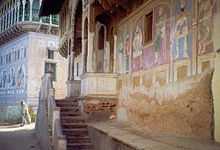Haveli
Haveli is the term used for a private mansion in India and Pakistan, usually one with historical and architectural significance. The word haveli is derived from Arabic haveli[1] probably through Persian hawli, meaning "an enclosed place." They share similar features with other mansions derived from Islamic Architecture such as the traditional mansions in Morocco called hawli
Mughal Havelis
Many of the havelis of India and Pakistan were influenced by Islamic Persian, Central Asian and Indian architecture. They usually contain a courtyard often with a fountain in the centre. The old cities of in Agra, Lucknow and Delhi in India and Lahore, Multan, Peshawar, Hyderabad in Pakistan have many fine examples of Mughal-style havelis.
Famous Havelis of India

The term Haveli was first applied in Rajasthan by the Vaishnava sect to refer to their temples in Gujarat. In the northern part of India havelis for Lord Krishna are prevalent with huge mansion like constructions. The havelis are noted for their frescoes depicting images of gods, goddesses, animals, scenes from the British colonization, and the life stories of Lords Rama and Krishna. The music here was known as Haveli Sangeet.



Later on these temple architectures and frescoes were imitated while building huge individual mansions and now the word is popularly recognized with the mansions themselves. Between 1830 and 1930, Marwari's erected [2] buildings in their homeland, Shekhawati and Marwar. These buildings were called havelis. The Marwaris commissioned artists to paint those buildings which were heavily influenced by the Mughal architecture.
The havelis were status symbols for the Marwaris as well as homes for their extended families, providing security and comfort in seclusion from the outside world. The havelis were to be closed from all sides with one large main gate.
The typical havelis in Shekhawati consisted of two courtyards — an outer one for the men which serves as an extended threshold, and the inner one, the domain of the women. The largest havelis could have up to three or four courtyards and were two to three stories high. Most of the havelis are empty nowadays or are maintained by a watchman (typically an old man). While many others have been converted into hotels and places of tourist attraction.
Famous Haveli In Marwar Area(Jodhpur Division):-
1) Havelli Heritage, Ahore https://www.facebook.com/Havelli.Heritage


The towns and villages of Shekhawati are famous for the embellished frescoes on the walls of their grandiose havelis, to the point of becoming popular tourist attractions.
The havelis in and around Jaisalmer Fort(also known as the Golden Fort), situated in Jaisalmer, Rajasthan, of which the three most impressive are Patwon Ki Haveli, Salim Singh Ki Haveli, and Nathmal-Ki Haveli, deserve special mention. These were the elaborate homes of Jaisalmer's rich merchants. The ostentatious carvings etched out in sandstone with infinite detail and then painstakingly pieced together in different patterns each more lavish than the next were commissioned to put on show the owner's status and wealth. Around Jaisalmer, they are typically carved from yellow sandstone.They are often characterized by wall paintings, frescoes, jharokhas (balconies) and archways.[3] .[4]
The Patwon Ji ki Haveli is the most important and the largest haveli, as it was the first erected in Jaisalmer. It is not a single haveli but a cluster of 5 small havelis. The first in the row is also the most popular, and is also known as Kothari's Patwa Haveli. The first among these was commissioned and constructed in the year 1805 by Guman Chand Patwa, then a rich trader of jewellery and fine brocades, and is the biggest and the most ostentatious. Patwa was a rich man and a renowned trader of his time and he could afford and thus order the construction of separate stories for each of his 5 sons. These were completed in the span of 50 years. All five houses were constructed in the first 60 years of the 19th century.[5] Patwon Ji Ki is renowned for its ornate wall paintings, intricate yellow sandstone-carved jharokhas (balconies), gateways and archways. Although the building itself is made from yellow sandstone, the main gateway is brown.
Famous Havelis of Marwar (Jodhpur) Area
1) Havelli Heritage, Ahore Dist.-(Jalore) Welcome to Havelli Heritage
Famous Havelis of Udaipur
Among the several Havelis in Udaipeli,
- Kanor-ki-Haveli,
- Karjali-ki-Haveli,
- Mamaji-ki-Haveli,
- Mataji-ki-Haveli,
- Salumbar-ki-Haveli,
- Sardargarh-ki-Haveli.
Famous Havelis of Delhi
- Chunnamal haveli
- Ghalib ki Haveli
Famous Havelis of Pakistan


There are a number of historically and architecturally significant havelis in Pakistan, most of which are situated in the Punjab province and constructed during the Mughal period.
Below is a list of some of the historically and architecturally significant havelis in Pakistan:
- Kapoor Haveli in Peshawar
- Mubarak Haveli in Lahore
- Haveli Asif Jah in Lahore
- Haveli Wajid Ali Shah in Lahore
- Choona Mandi Haveli in Lahore
- Haveli Nau Nihal Singh in Lahore
- Haveli Barood Khana in Lahore
- Lal Haveli or Chandu Di Haveli in Lahore
- Haveli Man Singh in Jhelum
- Lal Haveli in Rawalpindi
- Saad Manzil in Kamalia
- Khan Club in Peshawar
- Waziristan Haveli in Abbottabad, home of Osama bin laden
- Janjua Haveli in Malowal, Gujrat, Pakistan
- Haveli Mubashar Ali Janjua, in Matore, Kahuta, Rawalpindi
Havelis in popular culture
Haveli is an also a novel by Suzanne Fisher Staples and is a sequel to her Newbery Award-winning novel Shabanu: Daughter of the Wind. The story takes place in an old-fashioned haveli in Lahore, Pakistan.
See also
| Wikimedia Commons has media related to Havelis. |
